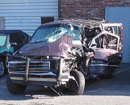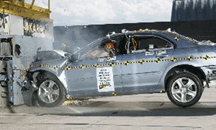Car-Accidents.com Home Page
Main Picture Gallery
Make Model Page
Crash Test Ratings Main Page
Types of Rollover
Rollovers occur in one of two ways: tripped or un-tripped.
Tripped Rollovers
NHTSA data show that 95% of single-vehicle rollovers are tripped . This happens when a vehicle leaves the roadway and slides sideways, digging its tires into soft soil or striking an object such as a curb or guardrail. The high tripping force applied to the tires in these situations can cause the vehicle to roll over.
See various types of tripped rollovers:
* Soft Soil
* Guardrail
* Steep SlopeOne of the best ways to avoid a rollover, therefore, is to stay on the road. Electronic Stability Control is a promising new technology that will help drivers stay on the road in emergency situations.
Un-tripped
Un-tripped rollovers are less common than tripped rollovers, occurring less than 5% of the time, and mostly to top-heavy vehicles. Instead of an object serving as a tripping mechanism, un-tripped rollovers usually occur during high-speed collision avoidance maneuvers.
* See an Un-tripped rollover
3. Are SUVs the only vehicles that roll over?
No. A rollover crash can happen in any type of vehicle. SUVs, like pickup trucks and minivans, typically ride higher off the ground than passenger cars and have higher centers of gravity, and thus are more susceptible to rollover if involved in a single-vehicle crash. See the vehicle class comparison chart. But while vehicle type does play a significant role, other factors such as driver behavior and road and environmental conditions also help determine whether or not a vehicle rolls over.
Even a five-star vehicle has up to a 10% risk of rolling over in a single-vehicle crash. In fact, certain five-star vehicles, such as sports cars, may have a higher number of rollovers per 100 registered vehicles than certain three-star vehicles, such as minivans, due to the aggressive way in which the vehicle is driven and/or the age and skill of the driver.
CausesRollovers are complex crash incidents and are particularly violent in nature. Rollovers, more so than other types of crashes, reflect the interaction of the driver, road, vehicle, and environmental factors. So while vehicle type does play a significant role, other factors such as driver behavior and road and environmental conditions can also cause a vehicle to roll over.
Vehicle Type
All types of vehicles can rollover. However, taller, narrower vehicles such as SUVs, pickups, and vans have higher centers of gravity, and thus are more susceptible to rollover if involved in a single-vehicle crash.
Speed
Fatal rollover crashes are speed-related more often than fatal non-rollover crashes. Some 40% of fatal rollover crashes involved excessive speeding . Additionally, nearly ¾ of fatal rollovers took place where the posted speed limit was 55 miles per hour or higher.
Alcohol
Nearly half of all fatal rollover crashes involve alcohol . Impairment can result from any blood alcohol concentration (BAC) above .00 . Even a small amount of alcohol will negatively affect your judgment, muscular coordination, and vision, making you more likely to lose control of your vehicle.
Location
Rural roads tend to be undivided and without barriers. They are thus more likely to be the scene of a fatal rollover. Almost ¾ of fatal rollovers occur in rural areas where the posted speed limit is typically 55 miles per hour or higher.
Routine Driving
NHTSA data also suggest that over 90% of the vehicles in fatal, single-vehicle rollover crashes were involved in routine driving maneuvers (going straight or negotiating a curve) at the time of the crash. This further suggests that driver behavior (distraction, inattentiveness, speeding, and impaired driving) plays a significant role in rollover crashes.
Single-vehicle Crashes
NHTSA data show that nearly 85% of all rollover-related fatalities are the result of single-vehicle crashes. This means that the majority of rollover crashes and fatalities do not involve any other vehicle besides the one that rolled over, further suggesting that driver behavior plays a significant role in rollover crashes.
FatalitiesRollovers are dangerous incidents and have a higher fatality rate than other kinds of crashes. Of the nearly 11 million passenger car, SUV, pickup and van crashes in 2002, only 3% involved a rollover.
However, rollovers accounted for nearly 33% of all deaths from passenger vehicle crashes. In 2002 alone, more than 10,000 people died in rollover crashes. The majority of them (72%) were not wearing safety belts.
Car Crash Pictures: Main Gallery

Crash Photos by Make & Model
Crash Tests are based on Vehicle Weight and Class. NHTSA categorizes vehicles by class and "curb" weight. Curb weight represents the weight of a vehicle with standard equipment including the maximum capacity of fuel, oil, coolant, and air conditioning. Passenger cars are further subdivided as follows:
Passenger cars – mini (PC/Mi) (1,500-1,999 lbs. curb weight)
Passenger cars – light (PC/L) (2,000-2,499 lbs. curb weight)
Passenger cars – compact (PC/C) (2,500-2,999 lbs. curb weight)
Passenger cars – medium (PC/Me) (3,000-3,499 lbs. curb weight)
Passenger cars – heavy (PC/H) (3,500 lbs. and over curb weight.)
Sport utility vehicles (SUV)
Pickup trucks (PU)
Vans (VAN)
Crash Test Info? Send them to us!!!
Car-Accidents.com is being built by our millions of viewers who have sent in their experiences and shared their pictures and stories. The stories told on Car-Accidents.com range from those of tragic loss, narrow escapes, cautionary tales and routine rear enders. You are invited to share your story with the millions of visitors we receive from around the the world.
General Guidelines for Sending Your Pictures and Story:
1. Please use either a jpg, bmp or gif format.
2. Tell us your story, there is no limit to what you can send us but please try include a description, date of the accident, (make model of the vehicle if known) and the accident location (City, State, or the Country if outside US). This makes for a more interesting page! You agree to our terms and conditions.
3. Send your photo and story toThank you!
Car Crash Photo Gallery: Hundreds of Car Accident Photos>>
See Car Crashes Organized By US states Here >>
View Car Accident Organized by Country >>
Car Accident Books >>
Find Car Crash Attorneys | Car Accident Statistics | Car Accident Pictures | Legal Rights and Information |
Truck Accidents | Submit Your Case >>
Head and Brain Injury | Auto Accident Reconstruction | Seat Belts save lives | Rules of Conduct at the Auto Accident Scene
Uninsured drivers | Car Accident Cases | Whiplash
Broken Bone Injuries
Herniated Disc Injury Claims
Car Accident Law by State
Massachusetts Accident Lawyers and Boston Lawyers
Find Car Accident Attorneys, By State Below:
Return to Car Accidents Home Page
All contents copyright Car Accidents.com

